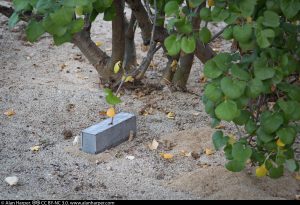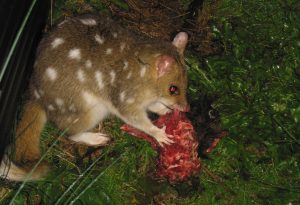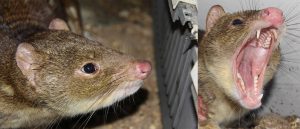Annie is a recently-graduated SNRE MS student. She currently works for her WEC graduate adviser, Dr. Bob McCleery.
Work
What was your research on?
My official master’s research was on small mammal communities in southern African savannahs, and how they respond to different vegetation gradients and their different foraging behaviors: looking at the landscape of fear within shrub and grass gradients.
When did you know you wanted to work in ecology? Is there an origin story?
I can’t remember not being obsessed with animals, from when I was a tiny child to now. It was all I was interested in, forever. I had fifty billion stuffed animals, and weird ones. I remember being really sick one Christmas, and getting a GIANT rhinoceros from my uncle. I LOVED the Disney Robin Hood, because all the characters were animals, and I had a lot of stuffed-animal foxes too. I was especially interested in the obscure animals that people didn’t know about. Playing twenty questions, I was always the annoying kid who picked echidnas and mandrills, because no one would ever guess those.
I went to private schools in Seattle, and one elementary school I went to would take a trip to the library every Wednesday. So every Wednesday I’d fill my backpack with all the nonficti
on animal books I could grab from the kids’ section then reload the next week. I went through a bug phase, then a penguin phase, then reptiles. I was fascinated with the rainforest and Australian animals.
I think I’ve always gone for the underdog. African megafauna is fine, but people already like them. Everyone knows about giraffes and lions. That’s why I learned about echidnas,
and platypus, and weird bugs and primates and reptiles.

What’s one word that describes how you work?
In bursts. I’ll focus on one thing at a time, and get it completely done in a few days.
Do you have a go-to tool?
I’ve done a lot of work with small mammal traps, primarily Sherman traps. I also did a lot of squirrel work in Canada, and we used larger, wire Tomahawk traps for them. Half of trapping is fixing traps that don’t work, adjusting the tension, and changing the lever that triggers them.

We had a problem in Canada with baby ground squirrels going into the traps. They travel together sometimes, so we were worried that if one went in, and another followed at just the wrong moment, it might get beheaded!
We put clothespins in the trapdoor, so it would close, but not all the way, and avoid injuring any squirrels.
In Canada we had a lot of ways to use traps, and strategize where to place them. It’s snowing, and there’s a lot of wind, so you don’t want to put it in a place where a squirrel might go in and get tossed down the mountain.
It might hail, so you have to put cardboard on the traps to protect them from that.
What’s your favorite organism you’ve studied and why?
If I had to go for my weird animals that no one knows about, I always tell people about the quoll, which is the largest native carnivore left on mainland Australia. It’s related to the Tasmanian devil. They’re pretty small, the ones I worked with were about the size of a guinea pig. The ones in the East are much bigger, and actually commonly called the native cat. I don’t like that name, because they’re marsupials and not closely related to cats.

I really like them!
We caught them for the project I worked on in Australia, and they were just terrible. They were very squirmy, and they would always try to bite you, and because they are carnivores they had very sharp teeth.
The same individual would go in the trap every night, for four nights, and every single time they’d be freaking out like they didn’t learn what happens from the last time.
We’d mark them using a microchip behind their head, which meant that there wasn’t much room on the animal to hold onto. You’d have to put your hand on the back of their head, and to apply just the right amount of pressure to hold them down. I started out holding them down too strongly, and they got stressed, so I loosened. It was a balance to make sure they were safe but also unable to turn around and bite you.
I liked how feisty they were, and they are really pretty. They’re polka dotted, with long tails.
What’s an unexpected experience you’ve had because of your work?

Credit Mike J Steinberg
I also worked with lemurs, but that wasn’t very unexpected, I just wanted to mention them.
Africa was awesome too. I always studied my weird animals first, but have nothing against African megafauna. It’s amazing to work in a place where elephants cross the road in front of you.
We had rhinos in our study plots all the time, and that was interesting. Most of the work was in Swaziland, which doesn’t have large mammals, but I did some work in Kruger Park too. We had game guards with us all the time, to keep us and the animals safe. There were rhinos around every day.
Sometimes we’d have to wait to go out on our plots, because a rhino would be eating or sleeping on them. That became routine.
One day the game guard paused and said, “There is a lion running straight towards us.”
I looked, but I could see nothing. It was the only time I saw her get freaked out.
I kept asking where the lion was, and she kept saying, “It’s right there, it’s right there!”
We sort of jogged back in the other direction, and I actually never saw the lion.
~
I got to fly in helicopter once; that was cool!
We were sampling marsupial diversity in my Australia job. We went to 8 different sites, four in one park and four in other places.
One of the sites was so remote that we had to take a helicopter out, stay there for a week, and pack MRE’s to eat. That was pretty fun. At half the sites, we caught nothing, and the other half we caught everything. Quolls, and bandicoots, and these little wallabies called monjons. They’re all very endangered, so we didn’t catch very many.
On the helicopter trip, we caught two mice, and a couple of dead lizards. It wasn’t a very exciting trip in that sense, but flying on the helicopter was very fun!
Lifestyle
How do you manage your time?
I work really well at night. I like that no one is distracting me, and I have a basically unlimited amount of time to work, because the only other thing I should be doing then is sleeping.
There’s no eating, or talking, or distractions.
How do you balance long periods in the field with your personal life?
I have no personal life. That’s the answer to that question!
I’ve worked on eight or nine field projects now. Of those, only two were in the US. One in Colorado and one in the Everglades, which was the only project where I had much of a personal life. Even then, that was because I had to defend for my master’s, so I would drive up to Gainesville from my field site regularly.
All the other jobs I’ve done have been international, in the middle of nowhere, for months at a time.
Four months in Peru, six in Madagascar.
I was already in Australia when I did the Australia job.
In Australia, we had a home base, so we’d go in the field for a few weeks at a time, then come back to a town called Kununurra. I had a few friends there, and we’d go to the tavern or karaoke.
It was near the border of the Northern Territory, but still a twelve hour drive from Darwin and a twelve hour drive from Broome. Field sites were all a six- to ten-hour drive on dirt roads from there. The town was mainly a mining town, which is about done I think. I don’t know how many people will stick around after that. There was also some tourism and a few cattle stations, but those are really big and far between.
How do you stay in touch with friends and family?
It varies. Some places I’ve been had internet. Australia had a phone. I didn’t know about WhatsApp at the time, which would have been handy.
Madagascar was the most remote, because we lived in a little village. We could get to town, but no one went regularly, because it was a multiday trip, and really miserable. The transportation there is mostly riding on tiny, cramped, rickety buses, on narrow mountain roads, and you might go for five hours without stopping. There are potholes everywhere, someone is throwing up in the back, and there are chickens on your feet.
I actually didn’t mind the chickens!

They’d usually sit on your feet like little foot warmers.
Anyway, we went maybe once every two weeks to once a month. I’d sent an email, and that was it.
I used to keep a blog, but haven’t had time since I started doing my own research. When you’re a field tech, you don’t have many days off, but when you’re not working, you’re not working and can do whatever you want with your time. In Madagascar, we had weekends.
It was almost too much time, there wasn’t enough to do sometimes!
It was fun though. There would be a soccer game every week in the village, so we’d go watch that.
I guess the answer to your question is: with difficulty, and sometimes not at all.
What do you do for fun?
Mostly art-related things. As in, “the arts”. I grew up in a family of actors, doing plays and musicals.
When I’m working, if we go to town, I do karaoke. I bring a little ukulele around with me.
In general: singing, ballroom dancing, watching musicals and theater shows, movies.
I like hiking and outdoorsy things when I’m not in the field, too.
What do you like about living in Gainesville?
I like how Gainesville has such a strong art scene, between the art fests, and the performances, and the artwork to go see. There are too many shows to see them all!
I like that it’s small enough I don’t need a car. Working around the world, and not getting paid a lot, it’s nice to not have to make the commitment of getting one. I bike everywhere.
If I can get a ride, I like how close we are to St. Augustine, and Cedar Key, and the springs. I went to one of the theme parks last year: Harry Potter World.
Have you got any wildlife jokes?
When I was working with marsupials in Australia, there was a particular way of tracking our experience. We had to be peed on, pooped on, bitten, and had a quoll escape from us. Once you’ve had all of those things happen to you, you’re officially quoll-ified!

What are you currently reading?
I read a lot of fantasy!
One book I read in the field a few months ago was Uprooted by Naomi Novik, about a bewitched forest that was trying to take over.
In Closing
If you could call yourself back when you started undergrad, what advice would you give?
I did a lot of things I really enjoyed in undergrad. It’s hard to look back and say what could have been better. Looking back, I feel like I could have had more fun if I hadn’t spent so much time procrastinating on homework or projects, while at the same time being overly perfectionist about them.
It would be better if I just did things ahead of time, and so more efficiently, and accepted my result.
In general, I’m trying to be better at keeping up with friends I’ve made doing fieldwork in different places.
I recently went back to Australia, and actually got the chance to stay with some researchers I made friends with during my work in Peru. That was fun!
It’s definitely a privileged life that allows me to meet someone in one place, and then visit them again in another. Of course, it’s hardest to keep up with the local people I get to know, who don’t have that privilege, like the Malagasy guides who can’t even usually get to the internet, or the Peruvians or Mexicans I worked with.
Is there anything else you’d like to tell people?
Nope!

This interview is by Rhett Barker, and has been lightly edited for clarity by Claire Williams and Rhett Barker.
Thanks to Annie Loggins for sitting down with us!
To learn more about the UF/IFAS Department of Wildlife Ecology and Conservation, click here!
To learn more about work done by Annie and others in the McCleery lab, click here!
The concept for this interview is based on an interview series by the University of Washington called How UW Works, which is in turn based on a series called How I Work by LifeHacker magazine.
 0
0
